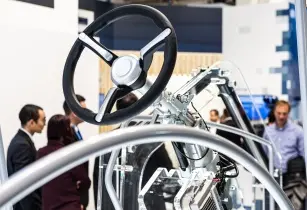SYSTEMS & COMPONENTS, a show that takes place alongside the AGRITECHNICA trade fair in Germany, will be offering insights into the digitalisation, automation and networking of mobile work machines
The show will be held from 27 February to 5 March 2022. The solutions on display on the trade fair grounds not only offer excellent vehicle handling and greater efficiency but are also designed to take the machines in the field or on the construction site to the next level of autonomy.
The trends at SYSTEMS & COMPONENTS 2022 include not only the automation of mobile machinery, but also the steadily growing number of intelligent assistance systems. Functions such as crosswind compensation, lane departure warning or hands-on-wheel detection intervene directly in the steering to support the driver and relieve him/her of routine tasks.
Steering and controlling made easy
Electrohydraulic steering valves enable speed-dependent steering assistance and automated driving functions. In this kind of steer-by-wire environment, the valves of the high-pressure circuits can be controlled with electrical commands, so that maintenance-prone hydraulic lines no longer need to be routed into the cab.
Electrohydraulic steering valves can receive multiple steering inputs, allowing the most appropriate input to be selected for the intended task. The electrical impulses from the joysticks are processed in real time in the on-board computer and converted into hydraulic movements. This allows the operator to steer the machine on the road with car-like steering, then switch to a more ergonomic alternative when lifting or grading.
Functionality under extreme conditions
“For end-users to reach the next level of productivity and significantly increase their efficiency, new concepts and technologies are needed,” said Roberto Ferrari, vice-president, Service & Operations of TTControl, a joint venture of TTTech Group and Hydac International, which specialises in the development of electronic control units and visualisation solutions for mobile machinery.
Unlike construction vehicles, agricultural machines often work in groups in close proximity in the field. The assistance systems facilitate operator-independent operation, for example in the form of precision farming with modern crop row recognition or precise movement control. This is made possible by the fusion of different sensor data and the processing of complex image data by high-performance electronic control devices in real time. Using synchronisation based on GNSS (Global Navigation Satellite System), combine harvesters or self-propelled forage harvesters today coordinate the speed and steering of the tractor, which drives alongside a transport trailer, fully automatically.








